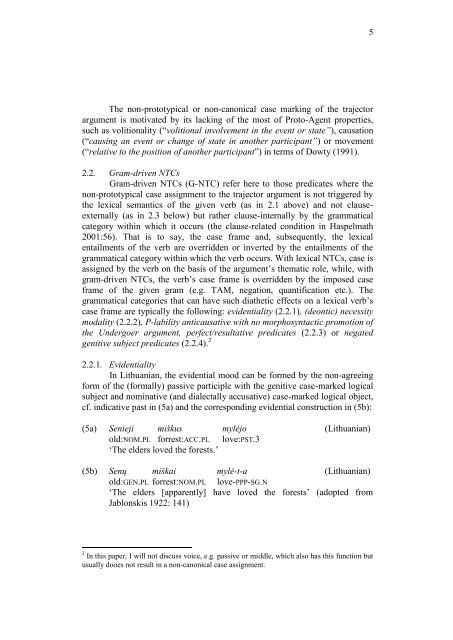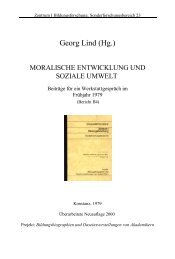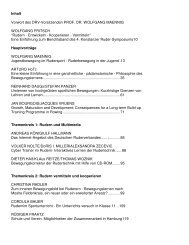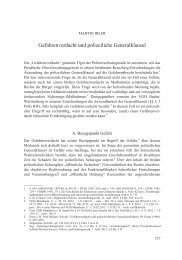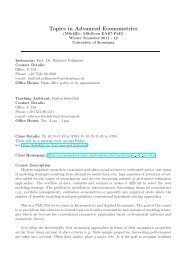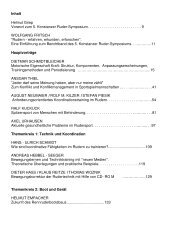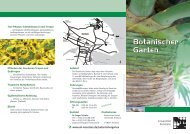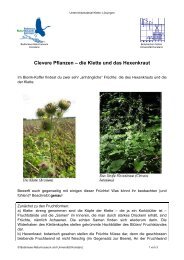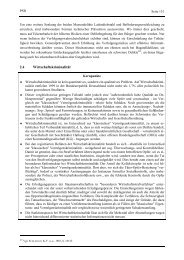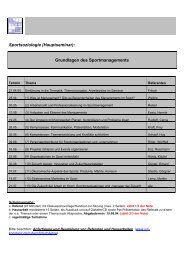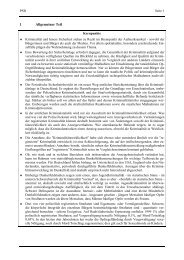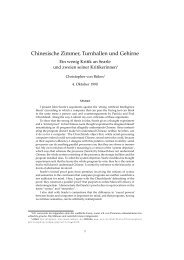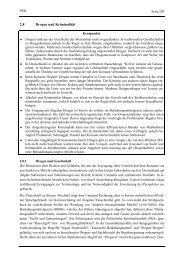Subjects and non-subjects in constructions
Subjects and non-subjects in constructions
Subjects and non-subjects in constructions
Create successful ePaper yourself
Turn your PDF publications into a flip-book with our unique Google optimized e-Paper software.
5<br />
The <strong>non</strong>-prototypical or <strong>non</strong>-ca<strong>non</strong>ical case mark<strong>in</strong>g of the trajector<br />
argument is motivated by its lack<strong>in</strong>g of the most of Proto-Agent properties,<br />
such as volitionality (“volitional <strong>in</strong>volvement <strong>in</strong> the event or state”), causation<br />
(“caus<strong>in</strong>g an event or change of state <strong>in</strong> another participant”) or movement<br />
(“relative to the position of another participant”) <strong>in</strong> terms of Dowty (1991).<br />
2.2. Gram-driven NTCs<br />
Gram-driven NTCs (G-NTC) refer here to those predicates where the<br />
<strong>non</strong>-prototypical case assignment to the trajector argument is not triggered by<br />
the lexical semantics of the given verb (as <strong>in</strong> 2.1 above) <strong>and</strong> not clauseexternally<br />
(as <strong>in</strong> 2.3 below) but rather clause-<strong>in</strong>ternally by the grammatical<br />
category with<strong>in</strong> which it occurs (the clause-related condition <strong>in</strong> Haspelmath<br />
2001:56). That is to say, the case frame <strong>and</strong>, subsequently, the lexical<br />
entailments of the verb are overridden or <strong>in</strong>verted by the entailments of the<br />
grammatical category with<strong>in</strong> which the verb occurs. With lexical NTCs, case is<br />
assigned by the verb on the basis of the argument‟s thematic role, while, with<br />
gram-driven NTCs, the verb‟s case frame is overridden by the imposed case<br />
frame of the given gram (e.g. TAM, negation, quantification etc.). The<br />
grammatical categories that can have such diathetic effects on a lexical verb‟s<br />
case frame are typically the follow<strong>in</strong>g: evidentiality (2.2.1), (deontic) necessity<br />
modality (2.2.2), P-lability anticausative with no morphosyntactic promotion of<br />
the Undergoer argument, perfect/resultative predicates (2.2.3) or negated<br />
genitive subject predicates (2.2.4). 2<br />
2.2.1. Evidentiality<br />
In Lithuanian, the evidential mood can be formed by the <strong>non</strong>-agree<strong>in</strong>g<br />
form of the (formally) passive participle with the genitive case-marked logical<br />
subject <strong>and</strong> nom<strong>in</strong>ative (<strong>and</strong> dialectally accusative) case-marked logical object,<br />
cf. <strong>in</strong>dicative past <strong>in</strong> (5a) <strong>and</strong> the correspond<strong>in</strong>g evidential construction <strong>in</strong> (5b):<br />
(5a) Senieji miškus mylėjo (Lithuanian)<br />
old:NOM.PL forrest:ACC.PL love:PST.3<br />
„The elders loved the forests.‟<br />
(5b) Senų miškai mylė-t-a (Lithuanian)<br />
old:GEN.PL forrest:NOM.PL love-PPP-SG.N<br />
„The elders [apparently] have loved the forests‟ (adopted from<br />
Jablonskis 1922: 141)<br />
2 In this paper, I will not discuss voice, e.g. passive or middle, which also has this function but<br />
usually dooes not result <strong>in</strong> a <strong>non</strong>-ca<strong>non</strong>ical case assignment.


